#indian paintings from india
Explore tagged Tumblr posts
Text
Types of Indian Paintings: How to Describe Indian Art
Learn about the different types of Indian paintings and how to describe them, from intricate details to rich cultural heritage and symbolism.
Traditional Indian Art
Traditional Indian art, which may also be called folk art or tribal Indian art in some cases, comprises distinct forms of visual art made by specific tribes or regions in India. These art forms are a beautiful expression of the rich culture and history of India, and their techniques have been passed down within families from one generation to the next.

There is no single style of traditional Indian art but rather various art forms developed in different states in India. Many use handmade colors and mineral pigments, and each is a unique craft that draws on Indian iconography and mythologies.

#indian paintings from india#indian paintings#"indian paintings art#Indian Art#asian art#painting#hospital bed rental san antonio tx#art
1 note
·
View note
Text
Some excerpts from Adv. Vrinda Grover's statement at the Supreme Court of India, as a part of the 15 petitions that were heard for the marriage equality bill. She presented arguments for the concept of a chosen family which was a more progressive stance on how families/unions could be defined by the constitution and it goes beyond just same-sex marriage. It could cover polyamory and recognition of queerplatonic intimacies between 2 or more individuals, and much more:
“During COVID, a study that was done on trans persons found that when trans persons due to lockdown and the nature of the disease, had to return to their natal families and their homes. Over there they faced violence. They faced conversion therapy which is prohibited. And that was actually an illustration of what would happen if other social formations of care and support did not exist. This is what has been described as an atypical family. This form of chosen family is recognized in our law; for instance, adoption.
Adoption is a form of chosen family. Today we recognize families and we conceptualize family as by blood, marriage or adoption."
"There is increasing legislative and judicial recognition of a person who may not necessarily be conjoined through marriage or conjugal intimacies. In relation to the advanced directive, every person who is not a minor shall have a right to make an advanced directive in writing specifying any of the following individual or individuals in order of precedents he wants to appoint as his nominated representatives.
"..Ensure that laws and policies recognize the diversity of family forms, including those not defined by descent or marriage and take all necessary legislative, administrative and other measures to ensure that no family may be subjected to discrimination on the basis of sexual orientation or gender identity of any of its members, including with regard to family related social welfare and other public benefits, etc. "
"I would say that what we are canvassing before this court is a different imagination. A new imagination of marriage and relationships and of family. An imagination which actually places at the foundation, love, care, and respect which may or may not come from the natal family because of my sexual orientation and gender identity.”
"There can be a feminist jurisprudence and feminist critique of family and that family can perpetuate caste purity and patriarchal control; so there may be persons who are of different sexual orientations and gender identities, which because of the hostility of natal families actually form intimacies that are non-marital, non-procreative, which are intimacies that are the only social conclave and support they can find."
Her statements were pleasantly surprising. Most of the earlier petitions chose to only focus on gay marriage and trans people having the right to marry, and I didn't expect any of the (star)lawyers/petitioners to go beyond that. But this. This is a sign of liberation. It reminds me a lot of the family code that granted marriage equality in Cuba. I love that we have some very progressive minds fighting this case.
#marriage equality#india#this better go well#lgbt#indian lgbt history#she was such a queen for this#a lot of the earlier petitioners werent intersectional enough#they were making points that painted same-sex marriage the cure all for most issues lgbt#someone said that “our families already accept us. now its just the courts that are left”#sir- no-#a lot of them came from upper caste hindu lgbt lawyers who have families that accept them so it's unsurprising#and so having vrinda and raju ramchandran speak after the govt tried to paint this as an issue of the elites was GOLDEN#SC better come up w the sexiest ruling in indian queer history or ELSE-#also w our temple art and kama sutra can yOu bEliEvE we have to fight for this#lgbtq
24 notes
·
View notes
Text
honestly i don't agree with terf ideology but to call it colonialist is interesting imo.
it’s always so fucking funny to me when terfs are like “how can you say trans women and women are the same thing! being born as a man makes you different!” because like. yes. trans women and cis women are different. so are black women and white women. and straight women and queer woman. and women from different countries and different socioeconomic statuses. there’s diversity in the experience of womanhood? what a wild concept
#like i can only speak as an indian (like parents from india)#like i've met indians who thought their kids were so westernized because they don't hate trans people#(specifically my mother and her friends#both sides see a thing they don't like. they want to associate it with other things they don't like. but that's just...not how it works.#in a lot of non european languages the terms for gender and sex just aren't separate.#my parents are tamilian so that's the example i know but i heard arabic is a similar way#pen means woman and female. aan means man and male. the difference between the two isn't there in those languages.#if you thought language surrounding trans people was a mess in english wait till you're me#18 and not a native tamil speaker#trying to explain to your tamilian grandmother that despite the fact this person looks like a dude with makeup she's still a woman#like what i'm saying directly translated is “yes she's a man biologically but she's also a woman." which just#doesn't have the social context of english where woman is used for social things and female for biological/legal#like it's just incomprehensible to her because of the way tamil works#racism sexism homophobia and transphobia are all real#connected issues but that doesn't mean that everyone's either all or nothing#racist people can be lgbt-friendly#sexist people can be race conscious#idk why there's a need to paint terfs as a particularly racist group when that's ostensibly not true#it's not like terf ideology is always going to be a white woman who's strong mouthed.#sometimes it's an indian woman keeping her mouth shut abt the new hire for fear of losing her job and social life#idk is she colonialist now? because her language makes this whole idea almost incomprehensible to her?
114K notes
·
View notes
Text
Discover authentic Indian contemporary art at Zigguratss. Explore a diverse range of paintings, sculptures, prints, and more. Elevate your space with us today!
instagram.com/zigguratss
x.com/zigguratss1

#Buy Original Paintings Online Indian Art Pieces Online#Explore Unique Online Paintings#Shop Exclusive Contemporary Art#Buy Original Indian Art Online#Traditional Indian Artwork Store#Modern Art Paintings for Home#Discover Affordable Art Online#Vibrant Canvas Paintings for Sale#Abstract Art Pieces Online India#Authentic Indian Art Prints#High-Quality Oil Paintings India#Watercolor Art Collections Online#Handcrafted Indian Artwork#Online Art Gallery Experience#Folk Art Paintings from India#Captivating Wildlife Paintings#Indian Heritage Art for Sale#Customized Artwork Online#Budget-Friendly Canvas Prints#Exciting Deals on Art Online#Meet Talented Indian Artists#Experience Indian Abstract Art#Serene Landscape Paintings#Exclusive Collections for Home#Artistic Gifts for Every Home#original artwork#paintings#sculptures#original serigraph art#Drawings
0 notes
Text
Basuki Das Gupta: Indian artist, expert in Indian art, creates textured paintings that evoke emotions, from Bishnupur, West Bengal. Buy traditional Indian art of Basuki das gupta. His unique blend of hardboard, paper pulp, and thick acrylic paint results in captivating surfaces that transcend flatness. With a strong affinity for texture, Das Gupta's artwork offers a deeply physical and immersive experience for viewers. Explore the Indian Art gallery of Laasya Art and discover a wide range of traditional Indian Art, offering the chance to bring the beauty and cultural essence into your own space.
#indian art#top indian artists#artist from india#Indian classical art#buy traditional indian art#contemporary Indian artist#Basuki Das Gupta#commissioned paintings
1 note
·
View note
Text
THREE NEW SHARK SPECIES THIS WEEK!
The second week of July 2023 something extraordinarily beautiful happened, the findings of 3 new species of sharks for were announced
A new angel sharks species was identified, from the western Indian Ocean on the Mascarene Plateau and off southwestern India in 100–500 m depths, the Lea’s angel shark Squatina leae, was recognized to be different genetically and morphologically distinct from its congeneric species Squatina africanae, following unique morphological features. This species was first detected in 1988 after finding three unusual, small sharks, but till today was completely understood. The angel shark is named after one of the author’s fiancee’s late sister, Lea-Marie Cordt.
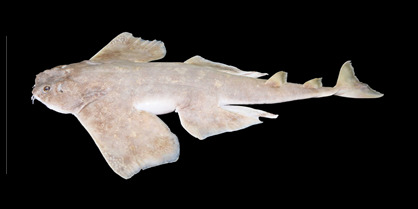
- Squatina leae, adult male, in dorsolateral.
Angel sharks are “flatter sharks”, possesing distinctly broad, dorsoventrally flattened bodies, a short snout with large mouth and nostrils, eyes on top of the head close to the large spiracles, very large pectoral fins, and a lateral caudal keel. They've evolved to be ambush predators, they lie in wait for prey to pass closely overhead before attacking.
Reference (Open Access): Weigmann et al., 2023. Revision of the Western Indian Ocean Angel Sharks, Genus Squatina (Squatiniformes, Squatinidae), with Description of a New Species and Redescription of the African Angel Shark Squatina africana Regan, 1908. Biology
From North Australia, another species of hornshark is described based on six whole specimens and a single egg case. The painted hornshark Heterodontus marshallae was previously considered to be the same with the zebra bullhead shark another well know bullhead shark from the central Indo-Pacific from Japan to Australia, but genetic and morphological analyses indicated the sharks were different, but looking alike. The painted hornshark is endemic to northwestern Australia and occurs in deeper waters, at 125–229 m below surface.
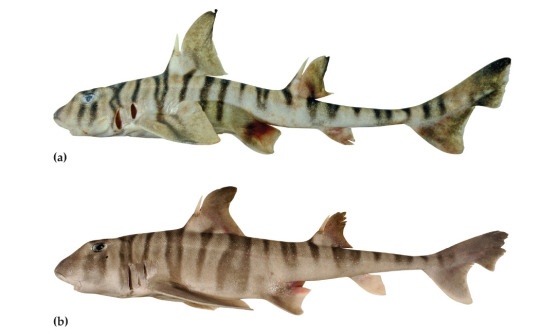
- Lateral view of two mature female painted hornshark Heterodontus marshallae showing small differences between individuals
The painted hornsharks is named in honour of Dr. Lindsay Marshall www.stickfigurefish.com.au a scientific illustrator and elasmobranch scientist who expertly painted all the sharks and rays of the world for the Chondrichthyan Tree of Life Project.
Reference (Open Access): White et al., 2023 Species in Disguise: A New Species of Hornshark from Northern Australia (Heterodontiformes: Heterodontidae). Diversity.
And from an unidentified shark egg collected from the deep waters of northwestern Australia, in 2011 recently helped researchers identify a new species of deep water cat shark. Called ridged-egg catshark Apristurus ovicorrugatus after its eggs, it was collected in the earlys 90 but remained unknown to date. This sharks presents white eyes, and is small in size, reaching less than a half meter in length. .
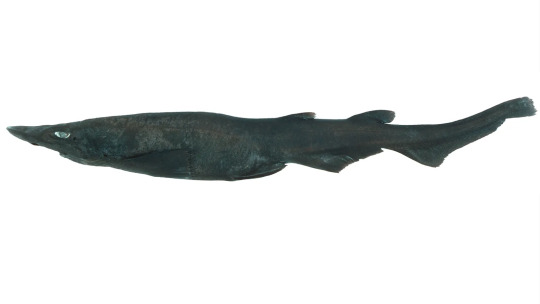
- Lateral view of female Apristurus ovicorrugatus before preserved. Photo by CSIRO.
Egg cases belonging to this species had been documented as early as the 1980s, but could not be matched to any species of Australian shark until recently scientists examined a shark specimen of previously uncertain identity in the CSIRO collection.
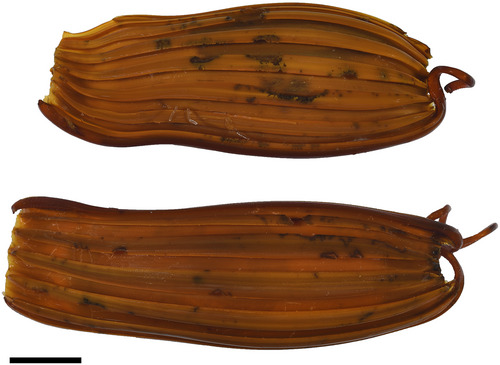
-egg cases of Apristurus ovicorrugatus. Scale bar is 10 mm
Reference (Open Access) White,et al., 2023 What came first, the shark or the egg? Discovery of a new species of deepwater shark by investigation of egg case morphology. Journal of Fish Biology.
#Squatina leae#Squatina#new species#elasmobranch#shark#biology#marine biology#science#marine science#indian ocean#bioblr#sciblr#sci#painted hornshark#Heterodontus marshallae#Heterodontus#Apristurus ovicorrugatus#Apristurus#long post#Ridged-egg catshark#Lea’s angel shark
3K notes
·
View notes
Text
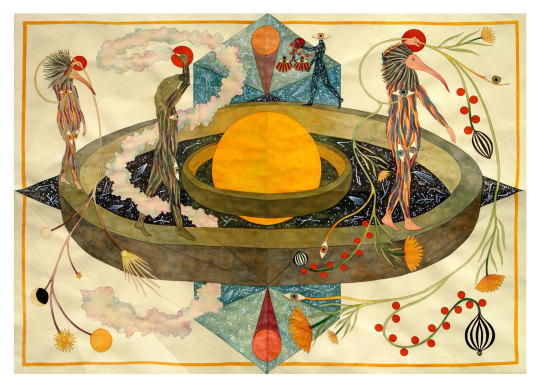


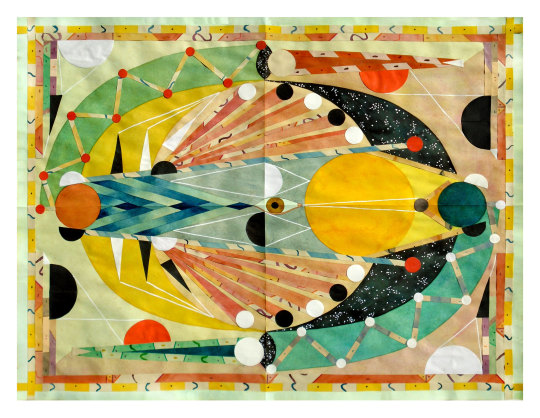

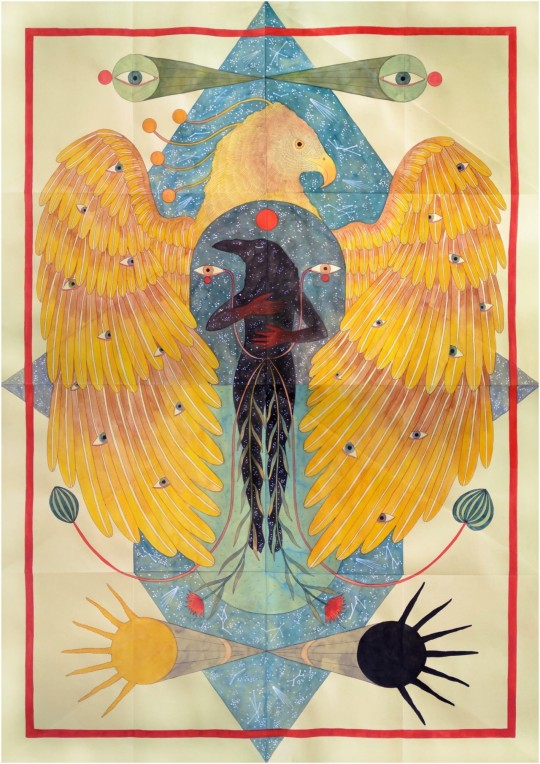

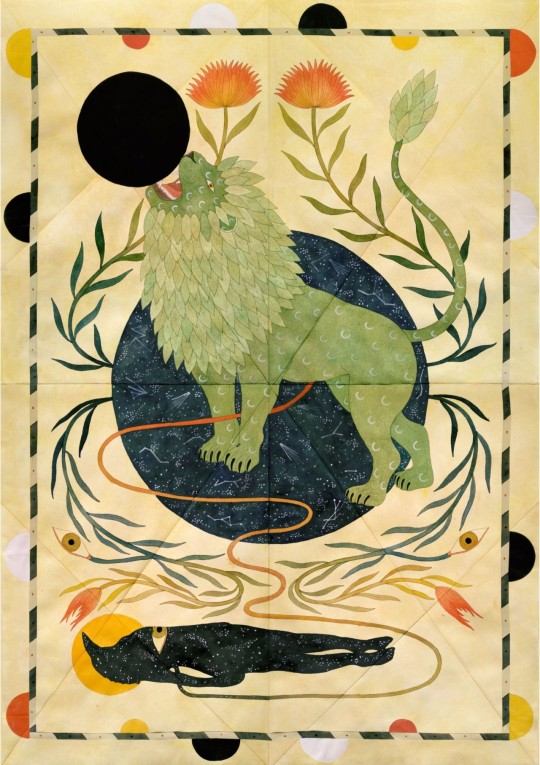
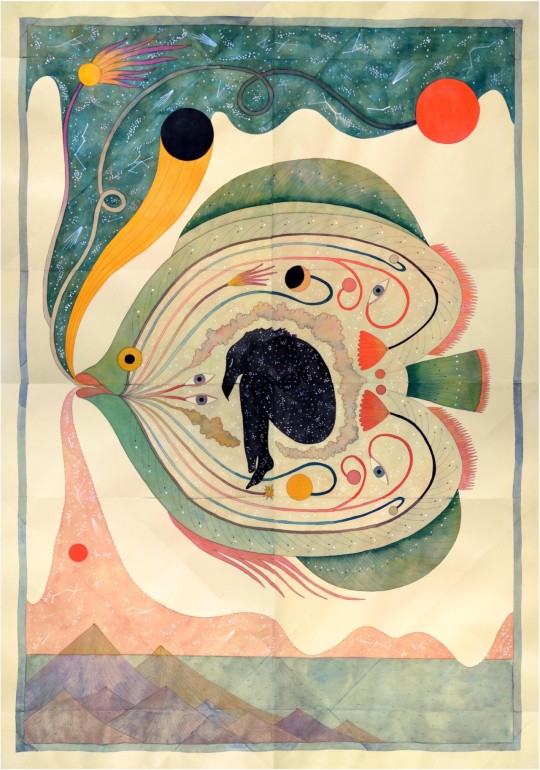
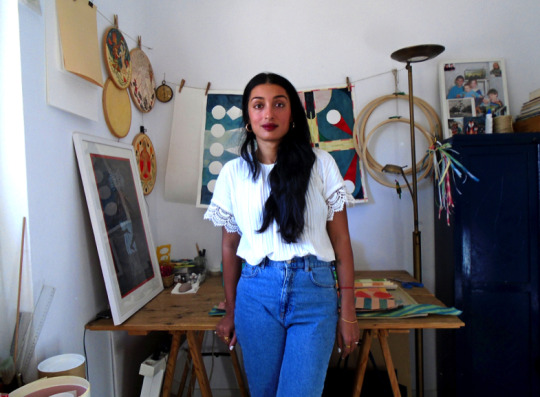
Rithika Merchant is a visual artist from Mumbai, India (b 1986). Her work explores the common thread that runs through different cultures and religions. Similar myths, stories and ideas are shared by cultures all around the world, her paintings explore this concept while also featuring creatures and symbolism that are part of her personal visual vocabulary.
Nature plays a pivotal role in her work and is emphasised by the use of organic shapes and non saturated colours. Her paintings and collages are made using a combination of watercolour and cut paper elements, drawing on 17th century botanical prints and folk art, to create a body of work that is visually linked to our collective pasts.
“I would like the viewer to place themselves in my work, regardless of where they are from,” says Merchant. “The figures in my works are also deliberately free of any race, gender, or ethnicity. I tend to be drawn to symbols that are universally recognizable and not culturally specific—like the eye, the sun, the moon, and botanical imagery in general.”
2K notes
·
View notes
Text
EXTERNAL INFLUENCES IN DUNGEON MESHI: INDIAN PHILOSOPHY
(SPOILERS FOR DUNGEON MESHI BELOW)
We know that Ryoko Kui spent considerable time at the beginning of working on Dungeon Meshi doing research and planning the series. Kui constantly references real world culture, history and mythology, but she also occasionally references real-world philosophy.
The story of Dungeon Meshi is full of philosophical questions about the joy and privilege of being alive, the inevitability of death and loss, the importance of taking care of yourself and your loved ones, and the purpose and true nature of desire. Kui explores these issues through the plot, the characters, and even the fundamental building blocks that make up her fictional fantasy world. Though it’s impossible to say without Kui making a statement on the issue, I believe Dungeon Meshi reflects many elements of ancient Indian philosophy and religion.
It’s possible that Kui just finds these ideas interesting to write about, but doesn’t have any personal affiliation with either religion, however I would not be at all surprised if I learned that Kui is a Buddhist, or has personal experience with Buddhism, since it’s one of the major religions in Japan.
I could write many essays trying to explain these extremely complex concepts, and I know that my understanding of them is imperfect, but I’ll do my best to explain them in as simple a way as possible to illustrate how these ideas may have influenced Kui’s work.
HINDUISM
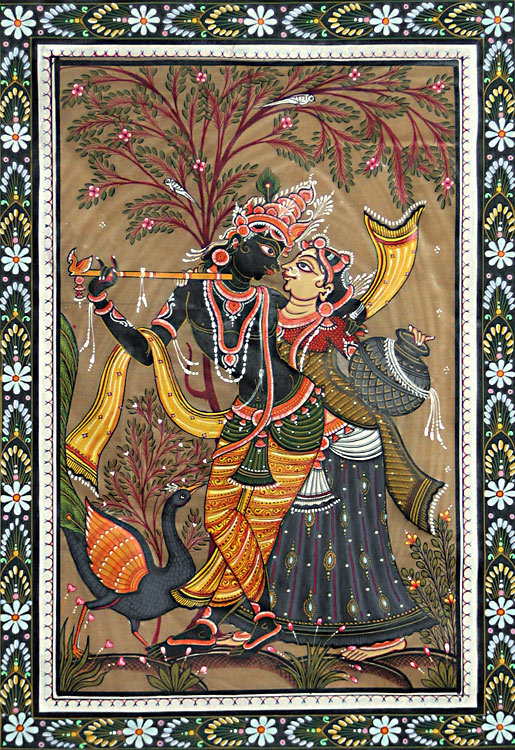
Hinduism is the third-largest religion in the world and originates in India. The term Hinduism is a huge umbrella that encompasses many diverse systems of thought, but they have some shared theological elements, and share many ancient texts and myths.
According to Classical Hindu belief, there are four core goals in human life, and they are the pursuit of dharma, artha, kama, and moksha.
Dharma is the natural order of the universe, and also one’s obligation to carry out their part in it. It is the pursuit and execution of one’s inherent nature and true calling, playing one’s role in the cosmic order.
Artha is the resources needed for an individual’s material well-being. A central premise of Hindu philosophy is that every person should live a joyous, pleasurable and fulfilling life, where every person's needs are acknowledged and fulfilled. A person's needs can only be fulfilled when sufficient means are available.
Kama is sensory, emotional, and aesthetic pleasure. Often misinterpreted to only mean “sexual desire”, kama is any kind of enjoyment derived from one or more of the five senses, including things like having sex, eating, listening to music, or admiring a painting. The pursuit of kama is considered an essential part of healthy human life, as long as it is in balance with the pursuit of the three other goals.
Moksha is peace, release, nirvana, and ultimate enlightenment. Moksha is freedom from ignorance through self-knowledge and true understanding of the universe, and the end of the inevitable suffering caused by the struggle of being alive. When one has reached true enlightenment, has nothing more to learn or understand about the universe, and has let go of all earthly desires, they have attained moksha, and they will not be reborn again. In Hinduism’s ancient texts, moksha is seen as achievable through the same techniques used to practice dharma, for example self-reflection and self-control. Moksha is sometimes described as self-discipline that is so perfect that it becomes unconscious behavior.
The core conflict of Hinduism is the eternal struggle between the material and immaterial world. It is often said that all of the material world is “an illusion,” and what this means is that all good and bad things will inevitably end, because the material world is finite. On the one hand, this is sad, because everything good in life will one day cease to exist, but on the other hand, this is reassuring, because all of the bad things will eventually end as well, and if one can accept this, they will be at peace.
The central debate of Hinduism is, which is more important: Satisfying your needs as a living thing, having a good life as a productive member of society, serving yourself, your family, and the world by participating in it the way nature intended? Or is it rejecting desire and attachment, discovering the true nature of existence, realizing the impermanence of material things, and that one can only escape the suffering that comes from the struggle of life by accepting that death and loss are inevitable?
There is no set answer to this question, and most believers of Hinduism tend to strike a balance between the two extremes simply because that’s what happens when a person leads a normal, average life, however there are also those who believe that pursuing extremes will lead to ultimate enlightenment and final release as well.
BUDDHISM
Buddhism is an Indian religion and philosophical tradition that originated in the 5th century BCE, based on teachings attributed to religious teacher the Buddha. It is the world's fourth-largest religion and though it began in India, it has spread throughout all of Asia and has played a major role in Asian culture and spirituality, eventually spreading to the West beginning in the 20th century.
Buddhism is partially derived from the same worldview and philosophical belief system as Hinduism, and the main difference is that the Buddha taught that there is a “middle way” that all people should strive to attain, and that the excesses of asceticism (total self-denial) or hedonism (total self-indulgence) practiced by some Hindus could not lead a person to moksha/enlightenment/release from suffering.
Buddhism teaches that the primary source of suffering in life is caused by misperception or ignorance of two truths; nothing is permanent, and there is no individual self.
Buddhists believe that dukkha (suffering) is an innate characteristic of life, and it is manifested in trying to “have” or “keep” things, due to fear of loss and suffering. Dukkha is caused by desire. Dukkha can be ended by ceasing to feel desire through achieving enlightenment and understanding that everything is a temporary illusion.
There are many, many other differences between Hinduism and Buddhism, but these elements are the ones that I think are most relevant to Kui’s work.
Extreme hedonism involves seeking sensual pleasure without any limits. This could just be indulging in what people would consider “normal” pleasures, like food, sex, drugs and the arts, but it can also involve doing things which are considered socially repugnant, either literally or by taking part in symbolic rituals that represent these acts. Some examples are holding religious meetings in forbidden places, consuming forbidden substances (including human flesh), using human bones as tools, or engaging in sex with partners who are considered socially unacceptable (unclean, wrong gender, too young, too old, related to the practitioner). Again, these acts may be done literally or symbolically.
Extreme ascetic practices involve anything that torments the physical body, and some examples are meditation without breathing, the total suppression of bodily movement, refusing to lay down, tearing out the hair, going naked, wearing rough and painful clothing, laying on a mat of thorns, or starving oneself.
HOW THIS CONNECTS TO DUNGEON MESHI
Kui’s most emphasized message in Dungeon Meshi is that being alive is a fleeting, temporary experience that once lost, cannot truly be regained, and is therefore precious in its rarity. Kui also tells us that to be alive means to desire things, that one cannot exist without the other, that desire is essential for life. This reflects the four core goals of human life in Hinduism and Buddhism, but also could be a criticism of some aspects of these philosophies.
I think Kui’s story shows the logical functionality of the four core goals: only characters who properly take care of themselves, and who accept the risk of suffering are able to thrive and experience joy. I think Kui agrees with the Buddhist stance that neither extreme hedonism nor extreme self-denial can lead to enlightenment and ultimate bliss… But I also think that Kui may be saying that ultimate bliss is an illusion, and that the greatest bliss can only be found while a person is still alive, experiencing both loss and desire as a living being.

Kui tells us living things should strive to remain alive, no matter how difficult living may be sometimes, because taking part in life is inherently valuable. All joy and happiness comes from being alive and sharing that precious, limited life with the people around you, and knowing that happiness is finite and must be savored.
Dungeon Meshi tells us souls exist, but never tells us where they go or what happens after death. I think this is very intentional, because Kui doesn’t want readers to think that the characters can just give up and be happy in their next life, or in an afterlife.
There is resurrection in Dungeon Meshi, but thematically there are really no true “second chances.” Although in-universe society views revival as an unambiguous good and moral imperative, Kui repeatedly reminds us of its unnatural and dangerous nature. Although reviving Falin is a central goal of the story, it is only when Laios and Marcille are able to let go of her that the revival finally works… And after the manga’s ending, Kui tells us Falin leaves Laios and Marcille behind to travel the world alone, which essentially makes her dead to them anyway, since she is absent from their lives.
At the same time, Kui tells us that trying to prevent death, or avoid all suffering and loss is a foolish quest that will never end in happiness, because loss and suffering are inevitable and must someday be endured as part of the cycle of life. Happiness cannot exist without suffering, just like the joy of eating requires the existence of hunger, and even starvation.
Kui equates eating with desire itself, using it as a metaphor to describe anything a living creature might want, Kui also views the literal act of eating as the deepest, most fundamental desire of a living thing, the desire that all other desires are built on top of. If a living thing doesn’t eat, it will not have the energy necessary to engage with any other part of life. Toshiro, Mithrun, and Kabru are all examples of this in the story: They don’t take care of themselves and they actively avoid eating, and as a result they suffer from weakness, and struggle to realize their other desires.
Kui suggests that the key difference between being alive or dead is whether or not someone experiences desire. If you are alive, even if you feel empty and cannot identify your desires like Mithrun, you still have desires because you would be dead without them. The living body desires to breathe, to eat, to sleep, even if a person has become numb, or rejected those desires either to punish themselves, or out of a lack of self-love.
Sometimes, we have to do things which are painful and unpleasant, in order to enjoy the good things that make us happy. I believe Kui is telling us that giving up, falling into despair, and refusing to participate in life is not a viable solution either.
The demon only learns to experience desire by entering into and existing in the material, finite world. This experience intoxicates the demon, and it becomes addicted to feeling both the suffering of desire, and the satisfaction of having it fulfilled. This unnatural situation is what endangers the Dungeon Meshi world, and it’s only by purging the demon of this ability to desire that the world can be saved. The demon is like a corrupted Buddha that must give up its desires in order to return to the peaceful existence it had before it was corrupted.
The demon curses Laios to never achieve his greatest desires at the end of the manga, which manifests in several ways, such as losing his monstrous form, Falin choosing to leave after she’s revived, and being unable to get close to monsters because they are afraid of him. In some ways you could compare Laios to a Bodhisattva, a person who tries to aid others in finding nirvana/moksha, even if it prolongs their own suffering and prevents them from finding personal release. Laios gives the demon peace, but Laios himself will never be able to satisfy his desires, and must eventually come to accept his loss and move on with his life.
(This is an excerpt from Chapter 3 of my Real World Cultural and Linguistic influences in Dungeon Meshi essay.)
#dungeon meshi#delicious in dungeon#the winged lion#dungeon meshi spoilers#laios touden#mithrun of the house of kerensil#analysis#The Essay#After all the conversation about Mithrun I felt it was really important to drop this excerpt today
161 notes
·
View notes
Text

So recently this Tweet went viral on Twitter, which is generally stating something that is rather common that I have also noticed on the app. (I will say that I do believe antisemitism and anti-black racism to also be extremely normalized as well, perhaps to an even greater extent).
That being said this was the general response (found in the quote retweet and the comments) to the above tweet:













I wanted to put this together and show it to others on here because it seems that it is strongly indicative of how hated Indian people are in progressive spaces. And before someone comes after me to say this is largely online, I will state that this rhetoric is eerily similar to the discrimination I faced growing up as Indian and that I continue to face. Additionally, people online are people in real life, they carry this rhetoric in the real world too and Indian people exist online too, we see how people dislike us.
To dissect and debunk all the sentiments in the tweets above would take an immense amount of time and energy that I do not have. Even archiving and collecting these tweets caused me to fall into a spiral of stress and tension. You don't have to go through all of it, much of what is expressed is vile, but I am trying to point out something. And it's that racism against Indians has become normalized, perhaps even encouraged, obviously in right-wing spaces but in progressive and liberal-left wing spaces as well. If you click on the accounts of many of these people, you can see them advocating against other forms of racism, homophobia, transphobia, anti-Palestinianism etc. These are progressives, not your run-of-the-mill conservative bigots. Hostility is growing against Indians, out in the open, and it seems that not many are willing to combat or acknowledge it.
The tactics are the same of course, to take a vocal minority of a group of people and paint the vast majority as the same, effectively portraying the group as if it has monolithic ideas. This is obviously a ridiculous thing to do, but even more so when one realizes that India is home to 1.4 billion people, not counting Indians living in other countries. These are all individuals who hold their own complex ideologies and beliefs, it is not possible to condense them down to one stereotype.
Am I denying that Indian people have our own issues and bigotry (to say the least) surrounding anti-Black racism, misogyny, islamophobia, casteism etc. Absolutely not! I have spent much of my life trying to unpack these sentiments drilled into me from a young age, and I have tried to help my peers do too. I have also spent time in real world activism combating such issues, because it is the only way forward to a more equal society.
But just because our society has prejudice does not mean we should be subjected to such bigotry from other progressives or have the discrimination we face not be taken seriously. Even the worst among us does not deserve to have racist sentiments spewed against them because bigotry is wrong, point blank. We don't deserve to be called rapists, to be accused of all being racists, and say that racism against us is "self-inflicted". Indians do not deserve that, we just don't.
#i will request people to reblog this#racism against us has become so insanely normalized and I want more people to know#(if you don’t want to for whatever reason it’s fine of course!)#it’s just a request#racism#anti-indian racism#antisemitism#because of prejudice against zionists and israelis#twitter#indian
262 notes
·
View notes
Text
Two Crowleys
A while ago, the wonderful mind of @noneorother posted this meta about the puppets in the magic shop.
The observation that there appear to be two Crowleys in the shot of the puppet arrangement had me absolutely scratching my head and thinking they must be mistaken somehow.
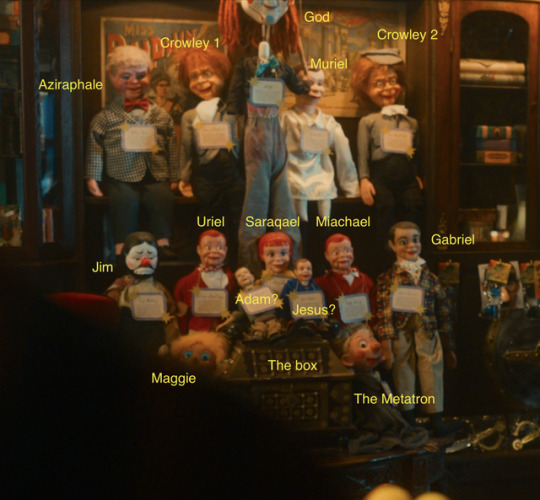
(pic from @noneorother)
But then I got my hands on some of the Amazon X-ray extras, and discovered these little gems from the album covers in Maggie's record shop:


Now, going back to our color-coding for a moment, we may not know what all the colors in Good Omens mean, and we may not have all the colors down. But we do know a few, and we know that color-coding in Good Omens does exist, and that it matters.
Auburn and vavoom yellow are Crowley's colors. They are the colors of his hair and eyes. Black and scarlet red are the colors he wears. So those four colors are Crowley-coded colors. Okay.
Thus, these two record albums from Maggie's shop are Crowley-colored. Now, notice something important? Well, two things. The first -- Raga Koboj has TWO little sharp-clawed critters peering out at us from behind blinds. I daresay they are meant to be little cartoon demons, yes? And CT Bazz: Dank Balaclava features a face in a red ski mask. People usually wear ski masks if A. it's cold as tits outside, or B. if they're trying to hide their identity. So both albums feature Crowley colors AND images of hiding -- plus one features an image of twinsies.
The other important thing takes us back to color-coding. What other color do we see here besides our well-known Crowley colors? On Raga Koboj, the auburn and vavoom yellow blend into each other -- creating orange between them. And Dank Balaclava features a cigarette being lit -- with a little flair of orange fire.
(Edit to add: The name of that first album is Raga Koboj, which is a style of Indian music. A very famous tale in India is of the Warrior Goddess Kahli fighting demons who kept replicating themselves. Every time a drop of blood would hit the ground, a new demon would spring up. She went on a rampage trying to destroy them all, and her husband had to throw himself in her path to stop her. Hmm . . .)
This leads me to believe two things: Yes, TWO Crowleys. One Crowley in hiding, the other a twin. And that orange is Crowley's secret color.
Where else do we see orange?

Yep, the pillars in Aziraphale's shop. Which we also know is painted Crowley Auburn on the outside and Vavoom Yellow on the inside. With accents of this nice saffron orange on the pillars.
Want more proof? Okay.
Several people have noted that Aziraphale and Crowley keep to each other's right and left, respectively. Aziraphale on the right, Crowley on the left. In season 1, whenever they are on the opposite sides of each other, something's up. Not wrong, necessarily, but not in proper order. As in the image-swap/body-swap. Several people have also noted that Crowley is on Aziraphale's right far more frequently in season 2. And look here:

Aziraphale looks instinctively to his left when Crowley approaches -- only this Crowley, the twin, is not approaching on Aziraphale's left. This happens in more than one scene.
And when Aziraphale introduces Crowley to Nina in the coffee shop in episode one, he says, "This is, um, Crowley." As if he's quickly deciding how to name this individual who looks like his demon but approached on his right. Aziraphale "ums" and hesitates a lot this season, but he's also lying a lot. Hesitation and "um" is one of his tells.
I believe Aziraphale knows this isn't Crowley 1.0. But he acts and talks to this Crowley as if it's Crowley 1.0, so I don't think it's an imposter or someone pretending to be Crowley who isn't. I think Crowley's split himself in two. Am I sure about that? No. But it's where I'm leaning at this moment.
But Crowley 1.0 isn't missing entirely. Look here:

Aziraphale is looking over his left shoulder for his demon, and Crowley's right there, where he should be.
So yeah, TWO Crowleys.
Now where the heck is Crowley while his twin is out walking around on Aziraphale's right side? I really don't know what he might be up to, but I think he's in contact. Reachable, at least.
Let's look at this one again. Who's this?

No, not the guy in the foreground. The guy in the back. No, not the dude wearing tartan, the other guy. The guy in front of the ORANGE pillar, the guy on Crowley-twin's LEFT shoulder.
Is that Crowley 1.0? Or at least, a way for Crowley to be in touch while he's off doing whatever the heck he's doing? I think it is.
Would you like some more proof?
Okay. How about another record album from Maggie's shop?
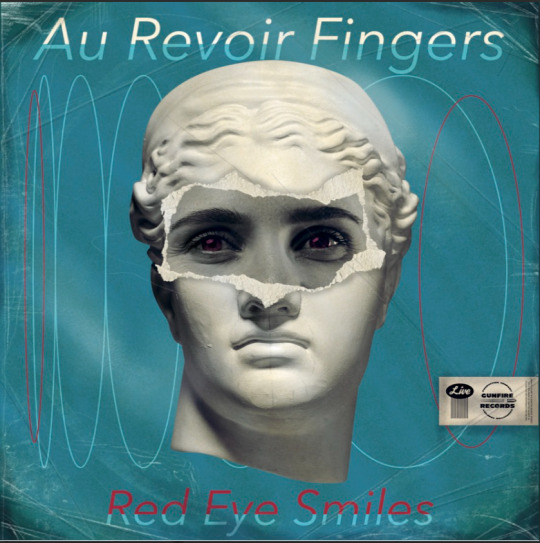
Back to color-coding again. That baby-blue/red combo seems to indicate Crowley and Aziraphale's relationship together. The baby-blue is the color of Aziraphale's shirt, while the red is one that Crowley wears, mostly around his neck, although it also appears elsewhere in his costuming.
Au Revoir, Fingers! Crowley's just a head now. But a head has ears and eyes, so Aziraphale can communicate with it. As I suspect he tries to here, before Jim interrupts:
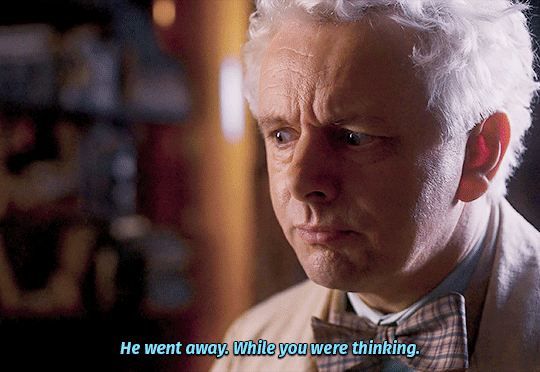
But wait. Back to Au Revoir Fingers for a moment. Red Eye Smile?
And red eyes? Fuck me.
A very few people have pointed out that there are lots of dual red taillights in multiple shots, frequently framed rather carefully. I had dismissed it, as I usually do when something turns out to be freaking important.

Someone's watching. I think it might be Crowley 1.0.
Then there's that bit where he's driving back to Whickber street, after coming back from Hell, and he first zooms around a bus with red taillights and says, "There's only room for one of us in this lane and it's not you," then he changes a pair of red stop lights to green and says "Don't you even think about it. There, that's better." Is he arguing with himself?? Telling the Other Crowley that it's his turn right now, not his? Of course I can't find a GIF or picture of that right now, but you know what I mean, right? Neil had to cut a bunch of material out of the finished show to fit Amazon's time limit requirements. That scene would seem to be an easy cut to make -- unless the scene matters to the overall plot too much to cut.
I also suspect that Crowley might be talking to himself in the book shop at the end of season 2. You know, when he turns Aziraphale's chair around to face the right way, but when Maggie and Nina come in it's facing the center of the room again? I suspect Crowley 1.0 and 2.0 had a chat. I do not know about what. Just sharing information?
I also wonder if Crowley 2.0 might have his own POV scenes -- thus confusing the already complicated POV situation even more. The white head statue sure gets several shots where it's in center frame, as if it is the POV character in that scene.
That's what I got, my fellow brain rotters. There's my evidence.
In conclusion: Two Crowleys. Yeah, I think so. Now, for the big question:
WHY???
What is Crowley doing that there needs to be two of him? And is it just twinsies, or is that someone else pretending to be Crowley and I'm wrong? Aziraphale definitely seems to know that's NOT his original Crowley, but tells the demon important information without hesitation, so I'm still suspecting Crowley twinned himself. But what if I'm wrong? Who is it then? And why are they pretending to be Crowley? And why does Aziraphale seem to know it's not Crowley, but still talk to him like it is?
I have no answers.
Thanks for crackpotting and going nuts with me, yet again. I hope this keeps you up at night like it's done me.
#good omens#good omens 2#crowley#aziraphale#good omens meta#ineffable husbands#good omens analysis#ineffable mystery#good omens fan theory#aziracrow#crowley twin#red eye smiles#book shop statues#good omens colors#good omens color theory#good omens color meaning#good omens clues#good omens theory#good omens speculation
150 notes
·
View notes
Text





“Could it be that human beings—whether Indian or Japanese—are like fishermen who cast their nets to fish but can only reach relatively shallow waters? We know a lot of things and are constantly learning more, but maybe what we have most in common with each other is what is unknown to us. The depths of the ocean, and our relationship to that world, still remain hidden and mysterious.” - Mayur and Tushar Vayeda
Brothers Mayur and Tushar Vayeda made this artists’ book. They are from the indigenous Warli community in Maharashtra, western India and grew up in the village of Ganjad. After studying animation and business management in Mumbai, the brothers taught themselves the traditional art of Warli painting.
Warli art is traditionally created by the women in the community, who decorate the walls and floors of their homes, as well as community spaces and for festivals. As such, Warli paintings were temporary, constantly renewed and recreated.
Today, both women and men make Warli painting, and they are also made more permanent on paper or canvas. The Vayeda brothers incorporate traditional Warli painting style but create a new vision.
In this book, the Vayeda brothers tell their journey from Ganjad to a small Japanese island called Awashima, connecting the village stream they knew from their childhood to the deep oceans they encountered in Awashima.
The deep for the text Arun Wolf and Gita Wolf from an oral narrative by Mayur Vayeda and Tushar Vayeda. Chennai : Tara Books, [2020] Vayeda, Mayur [artist] Vayeda, Tushar [artist] HOLLIS number: 99157144381803941
#WarliArt#WarliPainting#IndigenousArt#ArtistsBook#IndianArtists#MayurVayeda#TusharVayeda#HarvardFineArtsLibrary#Fineartslibrary#Harvard#HarvardLibrary
170 notes
·
View notes
Text






Cotton skirt-cloths produced in India for the Thai market in the 19th century. Cloth of this nature was made-to-order by Indian craftspeople, and combined Indian and Thai textile technologies with Thai motifs. Several of these cloths have been created using mordant-dyeing and draw-resist techniques; the gold paint in the first, fourth, and last cloths was probably added in Thailand.
Mordant-dyeing is a technique that uses natural dye alongside a dye fixative—in this case, a metallic salt—to chemically bind the colorant to the cloth, and produce more permanent colours.
In resist-dyeing, some areas of the fabric are covered to prevent them from taking on any dye. A drawn resist technique uses a resist, such as wax, mud, gum, or resin, that is drawn onto the fabric.
A resist-dyeing technique may also be combined with a block-printing technique: in which case, a resist is applied to a carved block or stencil, and then pressed onto the fabric.
Contrast these colours and patterns with those on cloth intended for the English and Dutch markets.
88 notes
·
View notes
Text
The Mast
One of the most important elements of a ship are the masts, because this is where the sails are attached that serve to propel the ship.
History
The oldest evidence for the use of one solid masts comes from the Ubaid site H3 in Kuwait, which dates back to the second half of the sixth millennium BC. There, a clay disc was recovered from a sherd that appears to depict a reed boat with two masts.

A painted clay disc with a diameter of 6.5 cm from site H3 with a design reminiscent of a boat with two masts, second half of the sixth millennium BC
In the West, the concept of a vessel with more than one mast to increase speed under sail and improve sailing characteristics developed in the northern waters of the Mediterranean: the earliest foremast was identified on an Etruscan pyxis from Caere (Italy) from the middle of the 7th century BC: A warship with a furled mainsail attacks an enemy ship and sets a foresail. An Etruscan tomb painting from the period between 475 and 450 BC depicts a two-masted merchant ship with a large foresail on a slightly inclined foremast.

Tomb of the Ship, mid-5th century BC
An artemon (Greek for foresail), which is almost as large as the main sail of the galley, is found on a Corinthian krater as early as the late 6th century BC; otherwise, Greek longships are uniformly depicted without this sail until the 4th century BC. In the East, ancient Indian kingdoms such as the Kalinga are thought to have been built in the 2nd century BC. One of the earliest documented evidence of Indian sail construction is the mural of a three-masted ship in the caves of Ajanta, which is dated to 400-500 AD.

This Ajanta mural depicts an ancient Indian ship with high stem and stern and three oblong sails attached to three masts. Steering-oars can also be seen. Location: Cave No. 2, Ajanta Caves, Aurangabad District, Maharashtra state, India, 400-500 AD
The foremast was used quite frequently on Roman galleys, where, tilted at a 45° angle, it was more like a bowsprit, and the scaled-down foresail attached to it was apparently used as a steering aid rather than for propulsion. While most ancient evidence is iconographic in nature, the existence of foremasts can also be inferred archaeologically from slots in the foremast feet, which were too close to the bow for a mainsail.

Fragment of mosaic depicting "navis tesseraria", a messenger and police boat of the African fleet, 2nd century AD
The artemon, together with the mainsail and the topsail, developed into the standard rigging of seagoing vessels in the Imperial period, which was supplemented by a mizzen on the largest cargo ships. The first recorded three-masters were the huge Syracusia, a prestigious object commissioned by King Hiero II of Syracuse and developed by the polymath Archimedes around 240 BC, as well as other Syracusan merchant ships of the time. The imperial grain freighters that travelled on the routes between Alexandria and Rome also included three-masted ships. A mosaic in Ostia (around 200 AD) shows a freighter with a three-masted rig entering the harbour of Rome. Specialised ships could carry many more masts: Theophrastus (Hist. Plant. 5.8.2) reports that the Romans brought in Corsican timber on a huge raft propelled by up to fifty masts and sails.
Throughout antiquity, both the foresail and the mizzen were secondary in terms of sail size, although they were large enough to require full rigging. In late antiquity, the foremast lost most of its tilt and stood almost upright on some ships.
By the beginning of the early Middle Ages, rigging in Mediterranean shipping had changed fundamentally: The spars, which had long since developed on smaller Greco-Roman ships, replaced the square sail, the most important type of sail in antiquity, which had virtually disappeared from the records by the fourteenth century (while remaining predominant in northern Europe). The dromon, the rowed bireme of the Byzantine fleet, almost certainly had two masts, a larger foremast and one amidships. Their length is estimated at 12 metres and 8 metres respectively, somewhat less than that of the Sicilian war galleys of the time.
Multi-masted sailing ships were reintroduced to the Mediterranean in the late Middle Ages. Large ships became more common and the need for additional masts to steer these ships appropriately grew with the increase in tonnage. Unlike in antiquity, the mizzen mast was introduced on medieval two-masted ships earlier than the foremast, a process that can be traced back to the mid-14th century based on visual material from Venice and Barcelona. To equalise the sail plan, the next obvious step was the addition of a mast in front of the main mast, which first appears in a Catalan ink drawing from 1409. With the establishment of the three-masted ship, propelled by square sails and battens and steered by the pivot-and-piston rudder, all the advanced ship technology required for the great transoceanic voyages was in place by the early 15th century.
In the 16th century, the cross-section of the masts was made up of several pieces of wood and held together with ropes and iron rings.

A lower mast with sections from 1773 to 1800
In order to achieve a greater height, the lower mast is extended, so that a total length of up to 60 metres can be achieved, measured from the keel. From lowest to highest, these were called: lower, top, topgallant, and royal masts. Giving the lower sections sufficient thickness necessitated building them up from separate pieces of wood. Such a section was known as a made mast, as opposed to sections formed from single pieces of timber, which were known as pole masts.

This is a section of HMS Victory's main mast
The forces of the sails on the mast construction are transferred to the hull construction by standing and running rigging, forwards and aft (stern) by stays, and laterally by shrouds or guys. In order to enable sailors to climb up into the rigging, which is particularly necessary for the operation of square riggers, rat lines are knotted into the shrouds like rungs of a ladder. The upper end of a ship's mast is called the masthead.
Mounting
The mast either stands in the mast track on the keel and is passed through the deck or it stands directly on deck. In the first case, the opening must be neatly sealed with a mast collar, otherwise water will penetrate into the living quarters. If the mast is on deck, it must be supported from below on the keel so that the loads do not bend the deck. Practically every sailing ship therefore has a more or less visible vertical support through the cabin.
Masts are usually supported by the standing rigging. The shrouds pull the mast downwards with several times its own weight and thus prevent it from tipping over.
Traditionally, when a sailing ship is built, one or more coins are placed under the mast as a lucky charm (according to my theory, the coins were also used as money to pay Charon the ferryman in the underworld if the ship sank); this custom is still practised today. Just as a horseshoe was nailed to the mast to bring good luck.
Mast types
For square-sail carrying ships, masts in their standard names in bow to stern (front to back) order, are:
Sprit topmast: a small mast set on the end of the bowsprit (discontinued after the early 18th century); not usually counted as a mast, however, when identifying a ship as "two-masted" or "three-masted"
Fore-mast: the mast nearest the bow, or the mast forward of the main-mast. As it is the furthest afore, it may be rigged to the bowsprit. Sections: fore-mast lower, fore topmast, fore topgallant mast
Main-mast: the tallest mast, usually located near the center of the ship Sections: main-mast lower, main topmast, main topgallant mast, royal mast (if fitted)
Mizzen-mast: the aft-most mast. Typically shorter than the fore-mast. Sections: mizzen-mast lower, mizzen topmast, mizzen topgallant mast
Some names given to masts in ships carrying other types of rig (where the naming is less standardised) are:
Bonaventure mizzen: the fourth mast on larger 16th-century galleons, typically lateen-rigged and shorter than the main mizzen.
Jigger-mast: typically, where it is the shortest, the aftmost mast on vessels with more than three masts. Sections: jigger-mast lower, jigger topmast, jigger topgallant mast
When a vessel has two masts, as a general rule, the main mast is the one setting the largest sail. Therefore, in a brig, the forward mast is the foremast and the after mast is the mainmast. In a schooner with two masts, even if the masts are of the same height, the after one usually carries a larger sail (because a longer boom can be used), so the after mast is the mainmast. This contrasts with a ketch or a yawl, where the after mast, and its principal sail, is clearly the smaller of the two, so the terminology is (from forward) mainmast and mizzen. (In a yawl, the term "jigger" is occasionally used for the aftermast.)
Some two-masted luggers have a fore-mast and a mizzen-mast – there is no main-mast. This is because these traditional types used to have three masts, but it was found convenient to dispense with the main-mast and carry larger sails on the remaining masts. This gave more working room, particularly on fishing vessels.
Cock, John. A treatise on mast-making , 1840.
Fincham, John. A Treatise on Masting Ships and Mast Making , 1854. Kipping, Robert. Rudimentary treatise on masting, mast-making, and rigging of ships , 1864.
Steel, David The Elements and Practice of Rigging, Seamanship, and Naval Tactics, Including Sail Making, Mast Making, and Gunnery , 1821.
Steel, David. Steel's Elements Of Mast-making, Sail-making and Rigging , 1794.
Layton, Cyril Walter Thomas, Peter Clissold, and A. G. W. Miller. Dictionary of nautical words and terms. Brown, Son & Ferguson, 1973.
Harland, John. Seamanship in the Age of Sail,1992
Marquardt, Karl Heinz, Bemastung und Takelung von Schiffen des 18. Jahrhunderts, 1986
#naval history#mast#parts of a ship#very long post#sorry#ancient seafaring#medieval seafarinh#age of discovery#age of sail#age of steam
104 notes
·
View notes
Text
Discover authentic Indian contemporary art at Zigguratss. Explore a diverse range of paintings, sculptures, prints, and more. Elevate your space with us today!

https://instagram.com/zigguratss
x.com/zigguratss1
#art and painting#buy original paintings online#buy original indian art online#modern art paintings for home#discover affordable art online#authentic indian art prints#Buy Original Paintings Online Indian Art Pieces Online#Explore Unique Online Paintings#Shop Exclusive Contemporary Art#Buy Original Indian Art Online#Traditional Indian Artwork Store#Modern Art Paintings for Home#Discover Affordable Art Online#Vibrant Canvas Paintings for Sale#Abstract Art Pieces Online India#Authentic Indian Art Prints#High-Quality Oil Paintings India#Watercolor Art Collections Online#Handcrafted Indian Artwork#Online Art Gallery Experience#Folk Art Paintings from India#Captivating Wildlife Paintings#Indian Heritage Art for Sale#Customized Artwork Online#Budget-Friendly Canvas Prints#Exciting Deals on Art Online#Meet Talented Indian Artists#Experience Indian Abstract Art#Serene Landscape Paintings#Exclusive Collections for Home
0 notes
Text


Photo 1 by Mark Sullivan.
“When I got Dark Horse Records, I had a couple of artists come up with logos, and there was one guy who painted one that looked really nice, with a nice color scheme, but it was a Chinese horse. I wanted something kind of different, and I was in India early in 1974 and I just thought I’m bound to find something if I keep my eyes open. One day I was in this placed called Udaipur and I looked across the street in the market, and I thought I could see some little pictures of enamel. And I got across the street and it was tins of paint on this stall. And I looked at all the tins, and they all had different labels on them, and one of them had the horse. It was a white horse but it had seven heads, and I thought, there’s my logo! I bought the tin can, brought it back and gave it to the artist and got him to make it dark and turn it ‘round so it would run the right way around the label. That’s the drag now about CDs: you don’t get to have any nice logos you can see turning.” - George Harrison, Goldmine, November 27, 1992 “[Jan Steward] created the logo for George Harrison’s record label, Dark Horse. It features the seven-headed flying horse Uchchahishravas from Indian art and mythology.” - The Los Angeles Times, August 11, 2020 “‘George always considered himself to be a dark horse — under the radar,’ [Olivia] says. ‘It’s interesting considering he was so out there [in the public]. But he was very internalized. If you looked at him onstage, he didn’t physically jump around and express himself like that. In that dark-horse way, people wouldn’t expect you to be a songwriter or be spiritual or funny, because you’re a dark horse. Nobody really knows what’s going on with you.’ Harrison told [Jim] Keltner he was starting his own record company and even showed him an illustration of the Uchchaihshravas, a seven-headed horse common in Hindu mythology, which would serve as the company’s logo. ‘He was just the king of all horses, the prototype for all horses, the best horse ever,’ says Dhani of the symbol. ‘He turned the tide in the battle and just generally was seen as this powerful vehicle for protection and overcoming.’” - Rolling Stone, March 9, 2020
#George Harrison#quote#quotes by George#quotes about George#Dark Horse Records#Olivia Harrison#Dhani Harrison#.Jan Steward#George and Olivia#George and Dhani#1970s#1974#Harrisongs#Harrison spirituality#fits queue like a glove
47 notes
·
View notes
Photo

Chidambaram
Chidambaram (Cidambaram) is an important Chola temple site in Tamil Nadu, southern India. Most of the temples at Chidambaram were built in the 12th and 13th centuries CE. The site is dominated by the huge gateway tower of the Nataraja temple but Chidambaram also boasts the first Devi or Amman shrine, the first Surya shrine with the distinctive stone chariot wheels which would adorn many subsequent temples, and the first large Siva Ganga tank. In this respect Chidambaram is something of a transitional site, linking elements of the old and new styles of Indian temple architecture.
The name Chidambaram, one of several from antiquity, derives from the Tamil Cirrambalam, meaning 'little hall'. The site was chosen because according to mythology it was the precise spot where the Hindu god Shiva had once danced in a grove of tillai trees. The dance was, in fact, a competition between Shiva and Parvati and naturally the great Shiva won. The story became a popular subject in Hindu art over the centuries.
The site is enclosed within four perimeter walls and covers a rectangular area of 55 acres. Within the compound are shrines, halls, temples, ornamental gateways, and a large ritual bathing pool, known as a Siva Ganga tank, which is surrounded by cloisters. Inscriptions claim the site was built by various Pandya kings and local rulers but none are contemporary with the dates the buildings were actually first constructed. The walls and east gopura (gateway) may be ascribed with greater certainty, and were probably built by Kulottunga III, who reigned from 1178 to 1218 CE.
The Nataraja temple was constructed between c. 1175 and c. 1200 CE. The actual temple shrine is relatively modest as by now in Indian architecture the gopuras had become the most important structures, at least in terms of aesthetics. The twin sacred chamber was, however, adorned with copper sheets covered in gold by successive Chola kings. The shrine is preceded by a dance hall and large entrance porch with columns (mandapa).
The massive granite and brick east gopura dominates the site but there are three other gopuras on the north, south and west sides (the earliest). The corbelled roofs diminish as the structures rise and are finally topped with the usual barrel-vaulted roof (sala), the eastern gopura also having a row of 13 decorative finials. The east gopura has a proper interior floor at each of its nine levels and there is an interior staircase which climbs to the very top of the building. All four gopuras have false windows on their facades, typical for this kind of structure, and pairs of pilaster columns set at regular intervals. The second floor of each gopura also has a passageway which worshippers ritually walked around. The entrance archways all have coffered ceilings decorated with relief panels.
Of particular note at Chidambaram are the thousands of sculptures adorning its buildings. In particular there are many statues of women in a wide variety of dance postures. Many statues are accompanied by quotations from Hindu literature which provide an invaluable reference for scholars. There are also figures of the four dvarapalas (guardian demons), the dikpalas (cardinal directions), many figures of Shiva performing heroic deeds, various other deities such as Vishnu, Devi, Sarasvati, and, unusually in southern architecture, river goddesses.
Finally, Chidambaram is also famous for its 17th century CE Nayaka ceiling paintings which decorate the Shivakamasundari shrine of the Nataraja Temple. More than 40 panels depict scenes from the life of the saint Manikkavachakar, a devotee of Shiva.
Continue reading...
90 notes
·
View notes